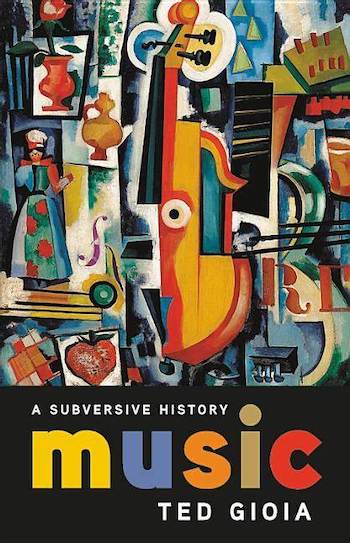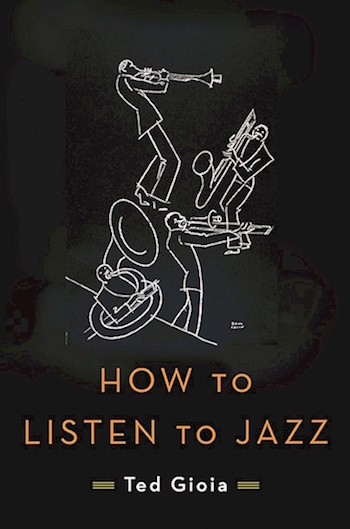Arts Coverage Commentary: A Conversation with Ted Gioia About New Approaches to Publishing
By Steve Provizer
“I don’t work the system anymore, except as a last resort: I aim instead to bypass it. The better I have gotten at circumventing gatekeepers, the more successful my writing career has been.”

Jazz critic Ted Gioia. Photo: courtesy of the artist.
When I started blogging about jazz about 12 years ago, the perception was that this was going to be an exciting new way to talk in depth about music. Of course, far too many 10 Best Lists were churned out, but there were also many knowledgeable back-and-forths on disputed aspects of the music and musicians.
For a few years, considerable communication took place via comments on the blogs themselves. It was also a period of intense conversations on Twitter, but jazz blogs didn’t seem to suffer from this competition. Then I began to notice more of these dialogues were moving to Facebook, whose jazz pages eventually exploded. Pretty much any kind of jazz or recording subset imaginable ended up being covered. At this point, the jazz blogosphere began to disintegrate, along with the end of any hope that these blogs could be monetized.
Then, in 2017, along came Substack. Blogs 2.0? Substack, a platform that enables writers to earn money for their work through email newsletters, has gone from 11,000 users in 2018 to 100,000 in 2020. The site now reports over 250,000. In Substack, newsletter subscribers pay rates from $0 to whatever the writer thinks the market will bear. Some authors choose to set a range of prices, which allows readers access to different levels of information. The subscription model means no ads and writers writing what they please, with no editorial oversight and no deadlines imposed from without. Substack takes a 10 percent fee and the writers get the rest.
Many well-known journalists, including Glenn Greenwald, Matt Taibbi, Matt Yglesias, and Andrew Sullivan have signed on (Note: Sullivan, Greenwald, and Yglesias have either made or increased their reputations through the power of their blogs). Some Substack contributors have resigned from the mainstream media outlets that employed them. Others have either partially or completely retreated from those outlets to concentrate on Substack.
Author Ted Gioia is now taking the Substack route. He is the author of 11 books, including The History of Jazz, Delta Blues, Work Songs, Healing Songs, and Love Songs. His book How to Listen to Jazz was reviewed here on the Arts Fuse. I talk to Gioia about his latest book, Music: A Subversive History, here. In 2017, he received a Lifetime Achievement Award in Jazz Journalism from the Jazz Journalists Association.
In this interview, Gioia has interesting things to say about writing for digital versus print, using social media, starting a subscription newsletter, and whether the Substack model could be used to distribute music. To subscribe to Gioia’s newsletter, go here.
Arts Fuse: Is writing for an online audience different than working in print media?
Ted Gioia: Back in 2007, I published my first completely digital article — no print version, just online access — and quickly learned how powerful the web is. Within 24 hours of uploading that article, I received 70 emails in response, some from halfway around the world. Web aggregators picked up the article and spread it further, stirring up discussions and debates along the way. I kept getting feedback for days.
That kind of instant connectivity had never happened when I wrote for print media. I made the decision at that moment to give a much higher priority to digital platforms — because of this extraordinary capacity it gives us for connecting with others.
As a book writer, you get used to an enormous time lag. It takes a year to get a book published — and that’s just the timeline after you submit the manuscript to the publisher. So it was both the speed and reach of the Internet that appealed to me.
AF: From 2007 until 2010, you served as founding president, editor, and blogger for www.jazz.com. Talk about what worked and didn’t work in that experience.
Gioia: Running a web periodical was exciting — and a real learning experience in many ways. I never thought I’d need to teach myself HTML programming in middle age, but that was only one of the new skills I had to develop. I was determined to know firsthand how every aspect of a web business functioned, and that kept me on a fast learning curve.
I was energized and having fun — and I think the writers working with me felt the same thing. Everything had to be done fast and in real-time — I mean, that’s web publishing in a nutshell. But the experience was exhilarating, especially after dealing with the ultra-slow New York publishing model.
But jazz.com had a tragic destiny. Site traffic was growing by double digits every month, and it seemed like we had a bright future ahead of us. But the mortgage meltdown and ensuing financial crisis caused my funding to dry up. That was a shame — because I believe we could have had a positive impact on the music and also reached profitability just given more time.
AF: What did you learn from that experience?
 Gioia: In the aftermath, I decided to work on projects where I was less reliant on gatekeepers and outside parties.
Gioia: In the aftermath, I decided to work on projects where I was less reliant on gatekeepers and outside parties.
For many of us in the creative economy, too much energy is spent on working the system. My response has been to operate in contexts where that isn’t such a time drain. I don’t work the system anymore, except as a last resort: I aim instead to bypass it. The better I have gotten at circumventing gatekeepers, the more successful my writing career has been. There’s a lesson in that, no?
AF: You have an MBA and extensive business experience, and you chose Substack as your newsletter platform. Why?
Gioia: Substack is the most supportive platform for writers I’ve ever seen. And this support is evident in many ways. They let the writer control all the intellectual property rights. They allow writers to keep 90 percent of the subscription revenues. They let writers maintain complete control over their email list. They allow writers to decide what to charge — or what to give away for free. They provide writers with comprehensive metrics, to a degree that no periodical has ever done in my entire writing career.
Here’s the sad part of this story. Newspapers could imitate all of this today — in fact, they could have done it years ago — and maybe enjoy some of the extraordinary growth that Substack is now demonstrating. But newspapers won’t do it. They will never do it. And for a simple reason: Their business model won’t allow them to operate with that degree of support, generosity, and transparency. Just imagine a newspaper that gave 90 percent of revenues to the writers. It will never happen.
AF: Is that a sustainable model?
Gioia: It’s sustainable, scalable, and very much applicable to other creative pursuits.
I’ve suggested that Substack make the same deal with musicians. Imagine a music streaming platform that gave 90 percent of revenues to the artists. Imagine a streaming platform that gave complete control on pricing to the musician. Imagine performers getting comprehensive metrics on their tracks in real time. Imagine musicians owning all of the rights to their music. If Substack goes down that path, they will shake up the music world like it’s never been shaken before. The record labels will feel like a martini in a James Bond movie.
AF: You write about many aspects of popular culture. Will the newsletter be eclectic or concentrate on one or two things?
Gioia: My newsletter will be more eclectic than you can imagine. I’ve already put together a plan for my writing over the next several months, and can promise that it will deal with matters far outside the normal purview of music and culture journalism. But in a good way…. and, yeah, also in a strange way too.
But my readers are open-minded, tolerant folks, so they will come along for the ride. At least that’s my hope.
AF: Have you set your pricing structure?
Gioia: I’ve been given a great degree of freedom in pricing. So I’ve decided to offer both free and paid subscriptions. In the early days, almost everything I publish will be free. Over time, I will add extras for paid subscribers.
Both groups are important. Writers need the paying subscribers to earn a living, and they need free subscribers to maximize their impact and reach. A healthy system rewards both groups, but in different ways. And it’s important to remember that free subscribers might eventually become paying subscribers — especially if they see value in what I do.
Once again, Substack has understood this better than most newspapers. Just look at how poorly they have implemented paywall strategies over the years. Many periodicals built paywalls with the idea they were creating a lavish castle behind a tiny moat. But in most cases, they actually constructed fortresses of banishment and exile, where writers are kept out of sight and mind.
AF: How many subscribers do you anticipate getting?
Gioia: I considered creating a budget and targets, but then abandoned the idea. Frankly, I have no idea what to expect. But the response during the first few days has been very encouraging.
I suspect that this will end up being much better than working for a newspaper or periodical from every possible angle.
AF: How does social media fit into this plan?
 Gioia: As I mentioned before, I made a decision around 10 years ago to build a direct connection with my readers. I was tired of dealing with gatekeepers. I had a hunch that my whole vocation would be energized by bypassing them. And that’s proven to be true — creating this direct contact with an audience has made everything about my writing more interesting, more productive, and more dynamic.
Gioia: As I mentioned before, I made a decision around 10 years ago to build a direct connection with my readers. I was tired of dealing with gatekeepers. I had a hunch that my whole vocation would be energized by bypassing them. And that’s proven to be true — creating this direct contact with an audience has made everything about my writing more interesting, more productive, and more dynamic.
So social media is a key focus. But not in a direct way. My major writing projects still take place outside of social media, but the connectivity those platforms provide is empowering to my projects.
And I need to emphasize that this was more than a career strategy. I enjoy this connection with people. I write for my reader. Perhaps that sounds like a truism, but it really isn’t. There are many writers who have higher priorities than serving the reader. Maybe they won’t say that out loud, but you can tell from their work. I am more aligned with Kierkegaard, who often talked about “that individual who is my reader.” I love that idea. You deal with the reader as if it’s a one-on-one relationship.
AF: I know you’re an active user of Twitter and occasionally Facebook. What other platforms do you use and what does the launch of this newsletter mean in terms of your use of social media?
Gioia: I have found that Twitter, for all its faults, is a much better platform for writers than Facebook or Instagram or LinkedIn or whatever. Here’s the difference: If you put up something interesting on Twitter, it can go viral and you will potentially reach thousands — or, sometimes, even millions — of people. But if you put up the same material on Facebook, they want you to pay for the privilege of going viral.
Facebook and most other platforms work to limit access to your readers. They want you to pay a toll just to reach your existing audience, and constrain your ability to add to it. I can understand their motivation — they want to make billions of dollars. Don’t we all? But the end result is a platform that’s a dead end for writers and other creative professionals.
So Twitter outplayed Facebook, at least for people in creative vocations. And that’s amazing, especially when you consider all the problems Twitter has created in other regards — it’s turned into the watering hole where bullies, trolls, and fanatics set up shop each and every day. But, for those who know how to use it, Twitter can be a source of bliss and nirvana too.
Alas, Twitter never capitalized on its potential as a publishing platform. Years ago, I suggested that they allow longer posts and actual articles — where the tweet could serve as the entry point into smarter, more in-depth material. If they had done that, Twitter might have prevented Substack and others from emerging. But that window of opportunity has now closed.
By limiting users to just a few characters, Twitter has ensured that it will never really be a good home for authors. Substack, in contrast, offers a smarter, more flexible way for writers and readers to interact — at least for communications longer than a couple of sentences.
AF: How will this affect your undertaking larger projects?
Gioia: I will still dedicate time every week to writing books. I recently finished the first draft of my next book, tentatively entitled How to Bring a Soul Back from the Dead with Music.
But here’s the twist. I might work with a traditional publisher on this project, or I might publish my next book on Substack. Or maybe I do a combination of both. The world is changing, and I am very committed to digital platforms. I’d prefer to work with publishers who understood the potential of hybrid approaches. But — how should I put this? — well, let’s say that recent history makes clear that legacy publishers haven’t been exactly nimble in dealing with change.

Jazz critic Ted Gioia. Photo: courtesy of the artist.
AF: Do you think many jazz writers will turn away from jazz publications to put out newsletters? Do you think the turn to newsletters marks a difference in the way the jazz community will get its news and share information?
Gioia: Music writers who want to build a career with the support of traditional media are likely to encounter many disappointments. The newspaper business is dying. Traditional print media are dying. Even many web-only periodicals haven’t even begun to figure out a strategy to pay the bills. I know how reluctant people are to take on the risk and reward of a more independent approach. But I suspect that events will force their hands.
AF: Do you think this is a positive development for writers in any field, and do you see it as a long-term trend that fits into the future direction of how readers will consume news and information?
Gioia: Every technological shift creates new opportunities and destroys old ones. If I had been a music writer in the 1950s or 1960s, I would have played by the rules of that era — and probably would have benefited from many of them. But those days are gone.
The good news is that the digital world provides writers with many new tools that, just a few years ago, we could have hardly dreamed of. I prefer to view the glass as half full. And, who knows, maybe we will get lucky and it will get filled up to the brim.
Steve Provizer writes on a range of subjects, most often the arts. He is a musician and blogs about jazz here.
